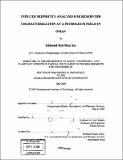| dc.contributor.advisor | M. Nafi Toksösz. | en_US |
| dc.contributor.author | Sze, Edmond Kin-Man | en_US |
| dc.contributor.other | Massachusetts Institute of Technology. Dept. of Earth, Atmospheric, and Planetary Sciences. | en_US |
| dc.date.accessioned | 2008-05-19T16:57:40Z | |
| dc.date.available | 2008-05-19T16:57:40Z | |
| dc.date.copyright | 2005 | en_US |
| dc.date.issued | 2005 | en_US |
| dc.identifier.uri | http://dspace.mit.edu/handle/1721.1/33722 | en_US |
| dc.identifier.uri | http://hdl.handle.net/1721.1/33722 | |
| dc.description | Thesis (Ph. D.)--Massachusetts Institute of Technology, Dept. of Earth, Atmospheric, and Planetary Sciences, 2005. | en_US |
| dc.description | Includes bibliographical references. | en_US |
| dc.description.abstract | This thesis presents the analysis and interpretation of passive seismic data collected in a 20-month monitoring period. The investigation is divided into four studies, each focusing on a different aspect of the seismic data to infer the reservoir properties. First, I applied three different methods (the iterative linearized, nonlinear grid-search, and double-difference methods) to relocate 405 microearthquakes that occurred between October 1999 and June 2001 in a producing field in Oman. A numerical technique is applied to "collapse" the relocated hypocenters and to find the simplest structural interpretation consistent with the data. Comparing the methods, the applicability of waveform correlation methods such as the double-difference in this case is limited by the relatively large number of events with dissimilar waveforms. Unlike the iterative linearized method, the nonlinear grid-search method gives the best results with the smallest average rms error of the absolute locations because it avoids the local minimum problem. | en_US |
| dc.description.abstract | (cont.) The relocated hypocenters clearly delineate nearly vertical, northeast-southwest striking faults near the crest of the field, which is consistent with the graben fault system mapped by surface geologic surveys and reflection seismic interpretations. I also performed statistical tests to estimate location errors, and found that the station geometry is the major factor that limits the accuracy of focal depths. Secondly, this thesis presents a non-linear wavelet-based approach to linear waveform inversion of high-frequency seismograms for the estimation of a point source mechanism and its time function. For earthquake mechanism inversions, it is important to stabilize the problem by reducing the number of parameters to be determined. Commonly, overlapping isosceles triangles or boxcar functions are used for the parameterization of the moment tensor rate functions (MTRFs). Here, I develop a wavelet-based strategy that allows us to construct an adaptive, problem-dependent parameterization for the MTRFs employing fractional spline wavelets. Synthetic results demonstrate that the adaptive parameterization improves the numerical approximation to the model space and therefore, allows more accurate estimations of the MTRFs. | en_US |
| dc.description.abstract | (cont.) The waveform inversion is performed in the wavelet domain and leads to a multiresolution sparse matrix representation of the inverse problem. At each resolution level a regularized least-squares solution is obtained using the conjugate gradient method. The wavelet-based waveform inversion method has been applied successfully in three real- data examples: the April 22, 2002 Au Sable Forks, New York earthquake, the September 3, 2002 Yorba Linda, California earthquakes, and 11 M>1 microearthquakes in a producing field in Oman. In the Oman field, the dominant styles of focal mechanism are left-lateral strike-slip for events with focal depths less than 1.5 km, and dip-slip along an obliquely trending fault for those with focal depths greater than 2.0 km. Thirdly, the covariance matrix method of shear-wave splitting analysis is presented. Different from conventional methods that usually analyze only two horizontal components, this method processes all three components of the seismogram simultaneously, allowing not only orientation but also dip information of fractures to be resolved. Synthetic test results show that this method is stable even for high noise level. | en_US |
| dc.description.abstract | (cont.) The method is applied to the Oman microearthquake records that display distinctive shear-wave splitting and polarization directions. From the polarizations, I estimate the predominant subsurface fracture directions and dipping angles. From the time delays of the split wave I determine the fracture density distributions in the reservoir. Finally, I examine the spatio-temporal characteristics of the microseismicity in the producing reservoir. The frequency-magnitude distribution measured by the b-value is determined using the maximum likelihood method. I found that b-values are higher for events below the deeper Shuaiba oil reservoir than those above. Also, the feasibility of monitoring the temporal change of b-values is demonstrated. The analysis of production and injection well data shows that seismicity event rates in the field all strongly correlated with gas production from the shallower Natih Formation. Microseismicity, focal mechanisms, GPS analysis, and production / injection well data all suggest the NE- SW bounding graben fault system responds elastically to the gas-production-induced stresses. Normal faulting is enhanced in the reservoirs by the compaction related stresses acting on the graben fault system. | en_US |
| dc.description.statementofresponsibility | by Edmond Kin-Man Sze. | en_US |
| dc.format.extent | 294 p. | en_US |
| dc.language.iso | eng | en_US |
| dc.publisher | Massachusetts Institute of Technology | en_US |
| dc.rights | M.I.T. theses are protected by
copyright. They may be viewed from this source for any purpose, but
reproduction or distribution in any format is prohibited without written
permission. See provided URL for inquiries about permission. | en_US |
| dc.rights.uri | http://dspace.mit.edu/handle/1721.1/33722 | en_US |
| dc.rights.uri | http://dspace.mit.edu/handle/1721.1/7582 | en_US |
| dc.subject | Earth, Atmospheric, and Planetary Sciences. | en_US |
| dc.title | Induced seismicity analysis for reservoir characterization at a petroleum field in Oman | en_US |
| dc.type | Thesis | en_US |
| dc.description.degree | Ph.D. | en_US |
| dc.contributor.department | Massachusetts Institute of Technology. Department of Earth, Atmospheric, and Planetary Sciences | |
| dc.identifier.oclc | 65168010 | en_US |
